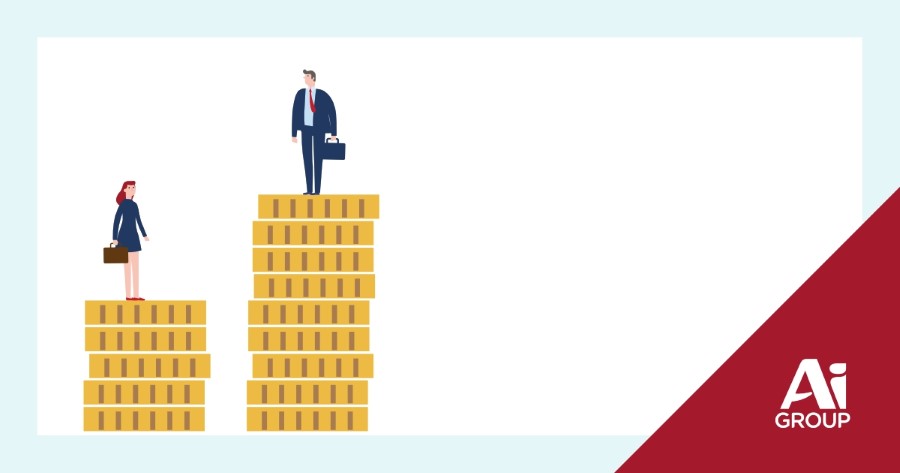
Practical steps to prepare businesses for the publication of employer gender pay gaps from early next year were revealed at an Ai Group webinar last week.
Employers are being urged to start now to meet the deadline for new reporting requirements — among other changes — arising from recent legislative amendments.
Previously, only industry and national numbers were published. Individual employer gender pay gaps were provided by the Workplace Gender Equality Agency (WGEA) to reporting organisations but only on a confidential basis.
Reforms have impacted not just reporting obligations for employers but how organisations should be engaging with workplace gender equality and narrowing the gender pay gap.
“Everyone has a role in this, and everyone can be part of the solution in terms of closing the gender pay gap,” webinar panellist and WGEA CEO Mary Wooldridge said.
The gender pay gap is not the same as equal pay; it is the difference in earnings between men and women.
WGEA, established under the Workplace Gender Equality Act 2012 (Cth) to promote and improve gender equality, produces two sets of numbers to reveal Australia’s gender pay gap.
One is based on the Australian Bureau of Statistics’ (ABS) average weekly earnings data produced every six months.
However, because ABS uses only base salaries and includes only full-time workers, WGEA produces a separate gender pay gap using total remuneration: base salaries plus other earnings (super, overtime, bonuses etc) and includes all workers – part-timers and casuals, too, with salaries annualised for comparison.
“Most part-time workers are women, so we’re not getting a full picture if their earnings aren't included in that gender pay gap calculation,” Ms Wooldridge said.
“When you include all workers and include total remuneration, the gap is significantly higher: 22.8 per cent compared to the (ABS) national gender pay gap of 13 per cent.”
ABS figures released yesterday — a week before Equal Pay Day next Friday — indicate a woman, on average, earns 87 cents for every $1 earned by a man.
Equal Pay Day marks the additional days from the end of a financial year women must work to earn the same average pay as men. This year it was an additional 56 days.
The industries with the biggest gender pay gaps (all greater than 22.8 per cent) are:
“By changing the legislation and implementing recommendations from a 2021 review of the Workplace Gender Equality Act, the Federal Government has been seeking to spark thought and conversation among employers, so they can put a plan in place for action,” Ms Wooldridge said.
“There’s a conversation about ‘let's really understand what's happening, to see if that aspiration of a gender-equal experience in the workplace is being lived by employees and whether the ambitions of organisations to have gender equality in their workplace is being realised.
“These reforms are seeking to drive that process, not only at an employee level, but also at a national level for broader engagement, so that the public can understand what's driving differences in gender equality.”
Legislative changes in the Workplace Gender Equality Act 2012 (Cth) and relevant recording instruments commenced earlier this year.
This impacted not just reporting obligations for employers but how they should be engaging with workplace gender equality and narrowing the gender pay gap.
“These changes outline what you need to do and how you should be framing your engagement and discussions around gender equality in the workplace, particularly with a focus on narrowing the gender pay gap,” webinar host Nicola Street, Ai Group’s Director of Workplace Relations Policy – Diversity, Equity & Inclusion, said.
Some questions previously voluntary will be mandatory from next year.
Employers will also be given the opportunity to provide extra information to explain the context of their situation and the steps they are taking.
WGEA’s Capacity-Building Manager, Samone McCurdy, who also spoke at the webinar, said: “This extra information could be in the form of a gender-equality strategy.
“It could be an action plan. It could even be a simple narrative that says: ‘This is why we believe we have our gender pay gap, this is what's driving it, and this is what we're doing about it.’”
Among other changes to facilitate greater accuracy, WGEA will collect employee age and location details, as well as CEO remuneration.
The entire federal public sector will report this year, and work is being done with state and territory governments, too.
A new gender equality standard has also been introduced.
“Previously, of the six gender equality indicators, organisations only needed to have a policy in relation to one,” Ms Wooldridge said.
“Now, if you've got more than 500 employees, you will need policies that cover all six indicators.”
A requirement for large employers to set targets to improve gender equality is under consultation.
A base salary and a total remuneration median gender pay gap will be published, as well as gender composition quartiles to give reporting organisations more information in their WGEA reports.
WGEA recommends following these steps to narrow the gender pay gap.
Dr McCurdy said: “We are acutely aware that a gender pay gap is a fairly blunt and broad instrument, so focusing on what’s driving the gap will speak to the experience of your employees.
“Look at things like your occupational pay gap level: where women and men congregate across different occupations and job roles in your organisation.
“Look at total remuneration, including any discretionary pay and patterns of hours.
“Where are your part-time/full-time workers? Your casual workforce? Where are compressed work weeks occurring?”
If you’re not doing so already, look at your exit interviews to find out why people are leaving the organisation and at what stage of their career.
Are they doing it in a gendered way?
Also, look at candidate pools.
“For example, we often get questions about how to attract more women to male-dominated industries,” Dr McCurdy said.
“One of the most important metrics is listening to what your employees are saying,” Dr McCurdy said.
“Do they feel safe and respected?
“Are there points in the employee life cycle where that changes, and are there parts of your organisation where that changes?”
Delivering gender equality starts from the top.
“No one group has to do this alone,” Dr McCurdy said.
“It’s a coalition of influence. When that happens, change progresses.”
“When you do have a gap — perhaps because you have a strong leadership team and there's not much room to move in terms of composition — explain that to your people,” Dr McCurdy said.
“Understand what your drivers are, and tell people what you're going to do about it (a gender pay gap).
“You can still build a great brand with an ‘explainable’ gender pay gap, particularly by amplifying and working on areas where your workforce is reflecting they're having a gender-equal experience.”
Using the UK as a base, WGEA will publish:
“The 2022-23 reporting everyone has just done will be the numbers that calculate the gender pay gap we will publish early next year,” Ms Wooldridge said.
“Most companies have now completed that reporting.
“When you complete reporting, you receive a reporting overview, which has your gender pay gap number.
“Most organisations already have the headline number, but you will get further information from us that shows exactly what will be published, well in advance of the publishing happening early next year.
“For an employer level, this will be the first year, and it will be a number.
“Next year when we publish, there will be a comparison to the year before.
“So, we'll be building the employer-level public information from this first publishing going forward.
“Not only will you be able to compare any changes, but you will be able to see what has effected that change,” Ms Woolridge said.
“This is now a journey. It's not a one-off.”
The UK has been publishing employer gender pay gaps since 2017 with promising outcomes.
Improvements weren’t fast, but there were improvements, and they were sustained.
“Every year, the UK continued to see improved outcomes,” Ms Wooldridge said.
“Publishing gender pay gaps has generated conversation and action at both an individual employer and national level.
“A lot of organisations have worked to identify what's driving disparity, and there has been significant engagement in boardrooms on these issues.
“So, we're reassured by the UK experience and are confident that will flow through to Australia.”
It is one of the reasons why CEOs of employers will be required to share WGEA’s findings (an executive summary of their own performance as well as their industry benchmark report) with their board of directors.
“The sharing of this information will generate discussions to help drive change," Ms Wooldridge said.
Employers who fail to comply with the Workplace Gender Equality Act requirement to report their gender pay gaps will be publicly named by WGEA and may be excluded from government contracts.
WGEA provides tools to help organisations:
The agency is also establishing an advisory service to support organisations.
A Roadmap to Closing the Gender Pay Gap FAQs
Ai Group can assist you in your reporting obligations under the Act and has further resources on the new prohibition on pay secrecy. Please contact Ai Group Workplace Advice Line on 1300 55 66 77 or for more detailed assistance, contact Ai Group Workplace Lawyers.

Wendy Larter is Communications Manager at the Australian Industry Group. She has more than 20 years’ experience as a reporter, features writer, contributor and sub-editor for newspapers and magazines including The Courier-Mail in Brisbane and Metro, the News of the World, The Times and Elle in the UK.